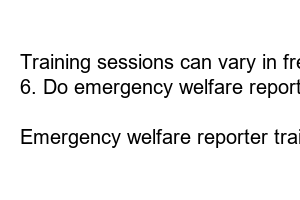긴급복지 신고의무자 교육
Title: Emergency Welfare Reporter Training: Empowering Communities in Crisis
Introduction:
In times of emergencies and disasters, timely and accurate reporting becomes crucial for effective response and aid distribution. Emergency welfare reporter training plays a vital role in empowering individuals with the skills needed to gather, analyze, and disseminate critical information during crises. Whether you are a journalist, a community volunteer, or simply interested in being better prepared, this blog post will explore the significance of emergency welfare reporter training and the benefits it can bring to communities in need.
1. What is Emergency Welfare Reporter Training?
Emergency welfare reporter training is a specialized program designed to equip individuals with the necessary skills to report and communicate essential welfare information during emergencies, such as natural disasters, public health crises, or social unrest. This comprehensive training covers a range of topics, including data collection, interviewing techniques, reporting ethics, and crisis communication strategies.
2. Enhancing Community Resilience:
By providing individuals with emergency welfare reporter training, communities become more resilient during times of crisis. Trained reporters can effectively convey information about available resources, evacuation procedures, health risks, and emergency protocols, enabling community members to make informed decisions and take necessary actions to ensure their safety and well-being.
3. Timely and Accurate Information Dissemination:
During emergencies, misinformation and rumors can rapidly spread, causing panic and hindering relief efforts. Emergency welfare reporter training emphasizes the importance of verifying information and reporting only reliable facts. Trained reporters act as a reliable source of information, helping to counter false narratives and ensure accurate updates reach those who need them most.
4. Bridging Communication Gaps:
In disaster-stricken areas, communication infrastructure is often disrupted, making it challenging to connect with affected communities. Emergency welfare reporter training equips individuals with alternate communication methods, such as using social media platforms, establishing community networks, or utilizing radio communication to bridge the gaps and relay vital information to those in need.
5. Collaborating with Local Authorities and Organizations:
Trained emergency welfare reporters act as a crucial link between affected communities and local authorities or relief organizations. Their training enables them to effectively collaborate and communicate with relevant stakeholders, enhancing coordination efforts and ensuring that emergency response initiatives are better aligned with the actual needs of the community.
6. Emotional Support and Empathy:
In crisis situations, emotional support and empathy are equally essential for affected individuals. Emergency welfare reporter training emphasizes the importance of compassionate reporting, taking into account the sensitivities and traumatic experiences of those impacted by the event. Trained reporters can relay stories that evoke empathy and raise awareness about the long-term psychological effects of emergencies.
FAQs:
1. Can anyone participate in emergency welfare reporter training?
Absolutely! Emergency welfare reporter training is open to anyone interested in becoming better prepared to contribute to their community during emergencies.
2. Is previous journalism experience required?
While previous journalism experience can be beneficial, it is not a requirement. The training is designed to accommodate participants from diverse backgrounds.
3. Are there any age restrictions for training?
The age requirements may vary depending on the training program and the nature of the emergencies it focuses on. However, many programs encourage participants of all ages to join.
4. Can emergency welfare reporters work remotely?
Yes, emergency welfare reporters equipped with appropriate training can work remotely by utilizing communication technologies or collaborating with local individuals present in the affected areas.
5. How often is emergency welfare reporter training conducted?
Training sessions can vary in frequency, ranging from one-time workshops to ongoing programs held at regular intervals. It is advisable to check local community organizations or emergency services for information on upcoming training opportunities.
6. Do emergency welfare reporters receive any certification upon completion?
Many training programs offer certificates or documentation of completion, recognizing the participants’ commitment to community welfare during emergencies.
Summary:
Emergency welfare reporter training plays a crucial role in empowering individuals to effectively communicate and report vital information during emergencies. With enhanced community resilience, timely and accurate information dissemination, and collaboration with local authorities and organizations, trained reporters contribute significantly to the successful management of crises. By undergoing this training, individuals can become an invaluable asset to their communities, offering support, empathy, and crucial information when it matters most.

